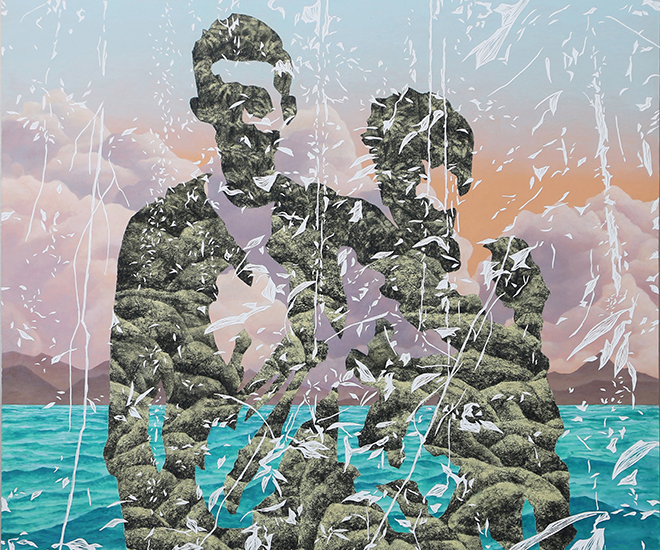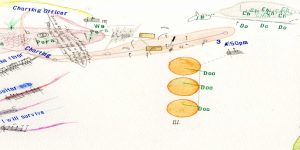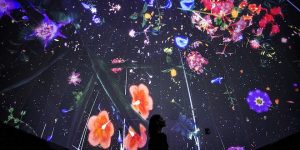‘In Praise of Shadows’ exhibition at ADM Gallery, NTU
An exhibition at ADM Gallery shows what darkness can reveal

Warren Khong, ‘#113’, 2017. Image courtesy ADM.
‘In Praise of Shadows’ at ADM Gallery in Nanyang Technological University, is a group exhibition curated by Michelle Ho. The show, which opened on 27 October 2017 and runs till January 2018, features works by Lavender Chang, John Clang, Ishida Takashi, James Jack and Warren Khong.
Light is an attractive and desirable thing. In an exhibition, we want artwork to be lit rather than shadowed. Jack’s ‘Natura Naturata: Light of Singapore’ (2017), installed on the floor-to-ceiling glass windows of the gallery, literally shines in the presence of light. The uneven strokes of carefully painted soil samples are seen against the tropical backdrop of lush greenery. The vision is evocative of a harmonious relationship between the man-made and natural worlds. In this work, light produces poetic focus.

James Jack, ‘Natura Naturata: Light of Singapore’, 2017. Image courtesy the artist.
In ‘Light of Singapore’, the colours saturate as the gallery darkens, allowing another kind of experience. The soil samples become less translucent and more opaque as the sun moves across the sky. While we may describe it as the dimming of lights, it is also an increase in shadow. And while shadows are usually seen as something to be avoided, this is merely a matter of perspective. These kinds of shadows are probably what that the novelist Junichiro Tanizaki, whose essay gave this exhibition its name, is describing. For Tanizaki, shadows are not absolute. Even when the eye believes it is looking at light, our vision is framed by the presence of shadows. They are varied and define the utopian idea of light.
In ‘Reflection’ (2009), Takashi chases sunlight over a month in a room. The painter’s body is absent in this time-lapse video but his brush is following wherever sunlight touches the wall, materialising arabesque and linear strokes. If the wall was basking in the sun, then Takashi was painting its tan lines. Each stroke evidences the wall’s past presence under the sun. But Takashi could never keep up. The sun continues to move and shine its light on different areas of the wall and he has to keep painting, sometimes even over the same area. In making the fissure between the real and pictorial visible, Takashi marries them, holding on to the past as the present and experiencing the present as more than just a moment, a shadow for a yet to be future.
Shadows articulate, clarify and define.
Against the shadowed walls of the darkened gallery, Chang’s solargraphs of ‘The Movingly Minute Scale of a Restricted Life’ (2015-16), produced with a camera obscura, glow. A bean plant is placed within the camera, obscuring the record of the image on the photographic paper. Since the clarity of solargraph is dependent on the strength of the light, the conditions create very dark images that challenge sight. In the gallery space, the muted surroundings calibrate the visitor’s eyes. The minute differences of shadow articulating the outside world and the shape of the bean plant become acute, clarifying themselves as distinct and defining themselves as darkened visions.

Lavender Chang, ‘The Movingly Minute Scale of a Restricted Life’, 2015-16. Image courtesy of artist.
With photography and painting, shadow only comes into visibility through a degree of substitution. Its presence is made material through integration with the pictorial. With Khong’s ‘#113’ (2017), however, the immaterial produces the material. In a reversal of Jack’s ‘Light of Singapore’, ‘#113’ paints with glass. Spotlights shine through and around square pieces of glass hung mid-air, creating a haunting shadow form on the wall that is the work itself. Unlike photographs and paintings, the visibility of this work is forever predicated on the presence of shadowed conditions, or differential light. In an evenly lit space, ‘#113’ disappears.
Shadows can also be metaphorical, a label for what we consider blights in our lives that we seek to banish. In Clang’s ‘A Light and a Shadow’ (2017), a homeless man and a passer-by are absorbed in conversation in a moment of unusual quiet on a street corner. Their quiet presence bring to mind the unconscious act of erasure we enact upon the homeless, the unacceptable body found in the shadowy parts of the city. Clang frames the men as equally dignified, possibly darkened by conditions but neither nuisances nor something to be feared.

John Clang, ‘A Light and a Shadow’, 2017. Image courtesy of artist.
Shadows are light’s essential mediator and the reason why we recognise light’s presence, for light is imperceptible, and defined by the absence of shadow. In his essay, Tanizaki draws on the image of Noh, a theatrical form that comes into being with haunting darkness. The sun and the artificial spotlights of the gallery give light to the works of this show. However, like Noh, they are also steeped in darkness, revealing themselves through the dark rather than the light.
More information at adm.ntu.edu.sg.
This article was written by Chloe Ho for Art Republik.









